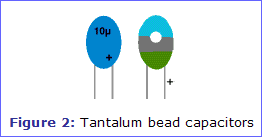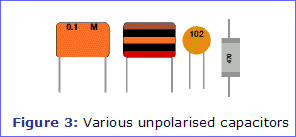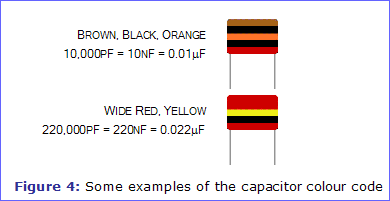|
Capacitors By John Hewes |
| |
||||
| |
Control your Meccano models (or anything else) from your Windows PC!
Take a look at my new MECControl project at meccontrol.com
Capacitors store electric charge. They are used with resistors in timing circuits because it takes time for a capacitor to fill with charge. They are also used in filter circuits because capacitors easily pass AC (changing) signals but they block DC (constant) signals.
Capacitor Values
This is a measure of a capacitor's ability to store charge. A large capacitance means that more charge can be stored. Capacitance is measured in farads, symbol F. However 1F is very large, so prefixes are used to show the smaller values.
Three prefixes (multipliers) are used, μ (micro), n (nano) and p (pico):
- μ means 10-6 (millionth), so 1000μF = 1F
- n means 10-9 (thousand-millionth), so 1000nF = 1μF
- p means 10-12 (million-millionth), so 1000pF = 1nF
There are many types of capacitor but they can be split into two groups, polarised (for large values, 1μF or more) and unpolarised (for small values, up to 1μF). Each group has its own circuit symbol.
Polarised Capacitors
Electrolytic Capacitors
| |
 |
Electrolytic capacitors are polarised and they must be connected the correct way round - at least one of their leads will be marked + or -. They are not damaged by heat when soldering.
There are two designs of electrolytic capacitors; axial where the leads are attached to each end (left of figure 1) and radial where both leads are at the same end (right of figure 1). Radial capacitors tend to be a little smaller and they stand upright on the circuit board.

It is easy to find the value of electrolytic capacitors because they are clearly printed with their capacitance and voltage rating. The voltage rating can be quite low (6V for example) and it should always be checked when selecting an electrolytic capacitor. If the circuit parts list does not specify a voltage, choose a capacitor with a rating which is greater than the circuit's power supply voltage. 25V is a sensible minimum for most circuits.
Tantalum Bead Capacitors
Tantalum bead capacitors are polarised and have low voltage ratings like electrolytic capacitors. They are expensive but very small, so they are used where a large capacitance is needed in a small size.

Modern tantalum bead capacitors are printed with their capacitance and voltage in full. However, older ones use a colour-code system which has two stripes (for the two digits) and a spot of colour for the number of zeros to give the value in μF. The standard capacitor colour code is used (see later in this article), but for the spot, grey is used to mean x0.01 and white means x0.1 so that values of less than 10μF can be shown. A third colour stripe near the leads shows the working voltage (yellow 6.3V, black 10V, green 16V, blue 20V, grey 25V, white 30V, pink 35V). Here are some examples:
- Blue, grey, black spot means 68μF
- Blue, grey, white spot means 6.8μF
- Blue, grey, grey spot means 0.68μF
Unpolarised Capacitors
| |
 |
Small value capacitors are unpolarised and may be connected either way round. They are not damaged by heat when soldering, except for one unusual type (polystyrene). They have high voltage ratings of at least 50V, usually 250V or so.

It can be difficult to find the values of these small capacitors because there are many types of them and several different labelling systems!
Many small value capacitors have their value printed but without a multiplier, so you need to use experience to work out what the multiplier should be:
For example, 0.1 means 0.1μF = 100nF.
Sometimes the multiplier is used in place of the decimal point:
For example, 4n7 means 4.7nF.
Polystyrene Capacitors
This type, shown on the right of figure 3, is rarely used now. Their value (in pF) is normally printed without units. Polystyrene capacitors can be damaged by heat when soldering (it melts the polystyrene!) so you should use a heatsink (such as a crocodile clip). Clip the heatsink to the lead between the capacitor and the joint.
Capacitor Number Code
A number code is often used on small capacitors where printing is difficult:
- The 1st number is the 1st digit of the value.
- The 2nd number is the 2nd digit of the value.
- The 3rd number is the number of zeros to give the capacitance in pF.
- Ignore any letters - they just indicate tolerance and voltage rating.
Here are some examples:
102 means 1000pF = 1nF (not 102pF!)
472J means 4700pF = 4.7nF (J means 5% tolerance)
Capacitor Colour Code
A colour code was used on polyester capacitors for many years. It is now obsolete, but of course there are many still around. The colours should be read like the resistor code, the top three colour bands giving the value in pF. Ignore the 4th band (tolerance) and 5th band (voltage rating). Note that there are no gaps between the colour bands, so two identical bands actually appear as one wide band.
The table below shows the meaning of each colour for each of the bands.
| Colour | Band 1 1st Digit |
Band 2 2nd Digit |
Band 3 Multiplier |
|||
| Black | 0 | 0 | x 1 | |||
| Brown | 1 | 1 | x 10 | |||
| Red | 2 | 2 | x 100 | |||
| Orange | 3 | 3 | x 1,000 | |||
| Yellow | 4 | 4 | x 10,000 | |||
| Green | 5 | 5 | x 100,000 | |||
| Blue | 6 | 6 | x 1,000,000 | |||
| Violet | 7 | 7 | - | |||
| Grey | 8 | 8 | - | |||
| White | 9 | 9 | - | |||
Figure 4 shows a few examples of the capacitor colour code.

 Shopping List
Shopping List
If you don't have any capacitors, you may want to buy a starter pack to get some in stock.
Part
DescriptionQuantity
RequiredRapid
CodeUnit
PriceTotal
PriceCeramic Capacitor Pack 1 13-0206 £13.61 £13.61 Electrolytic Capacitor Pack 1 13-0221 £9.96 £9.96 Grand Total £23.57
Order the above items from Rapid Electronics via our Circuits Shop and help support the Electronics in Meccano website, without affecting the price you pay! Just click on an item for information about it and/or to add it to your Rapid order.
Orders can also be placed by telephoning Rapid on 01206 751 166 or visiting their website at www.rapidonline.com. Prices quoted include VAT at 20%.
|
|
| Article Information |
Top of Page | Homepage | About | Search | Topics | Features | Circuits Shop | yourEiM |
© 1998 - 2024 Tim Surtell |